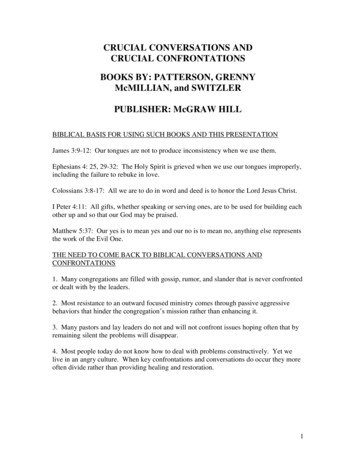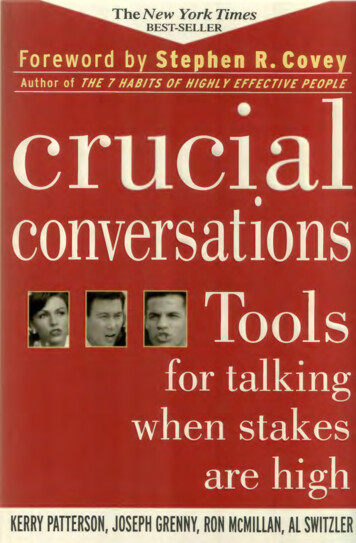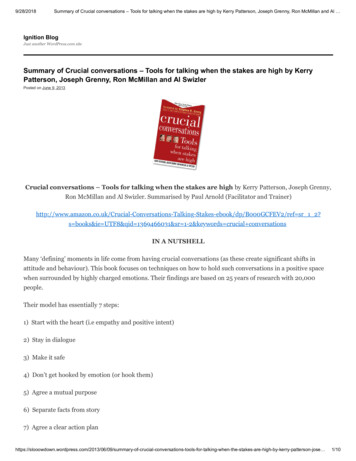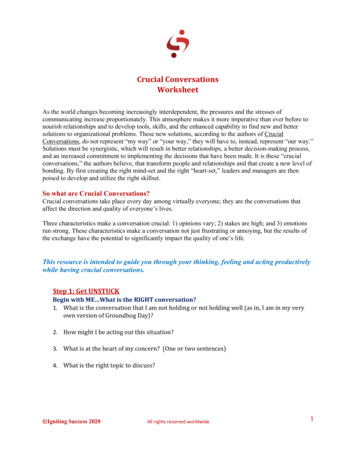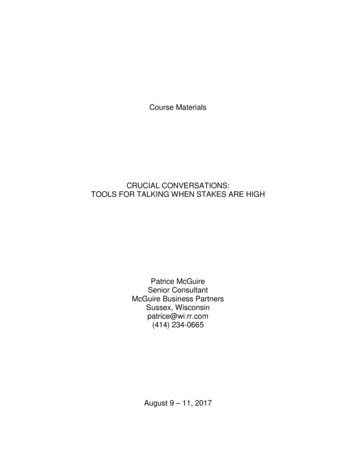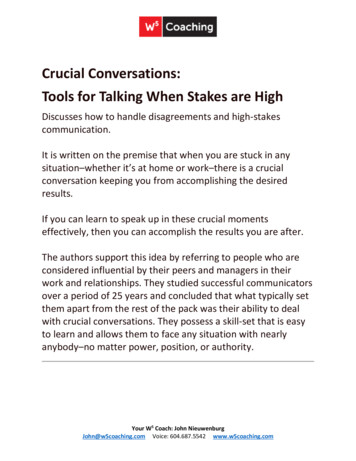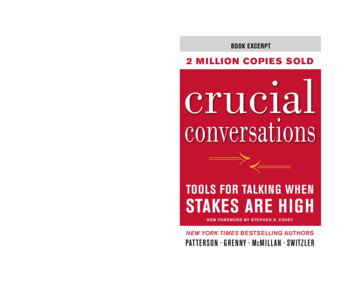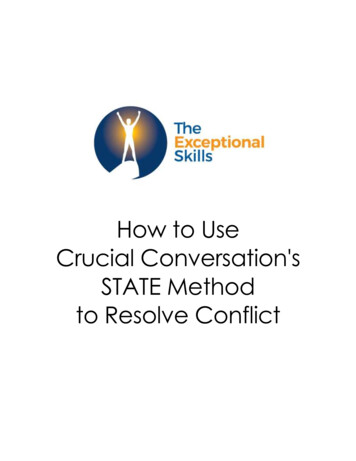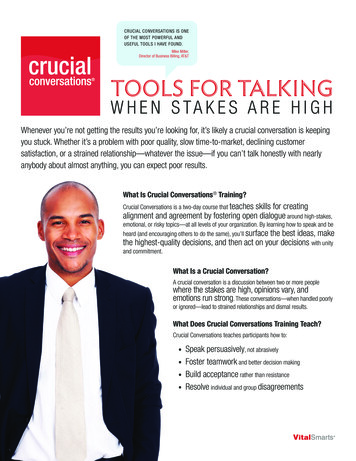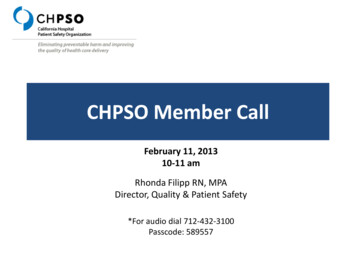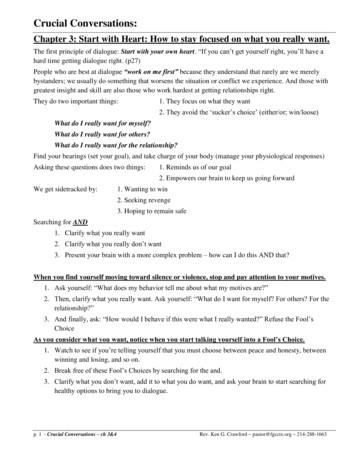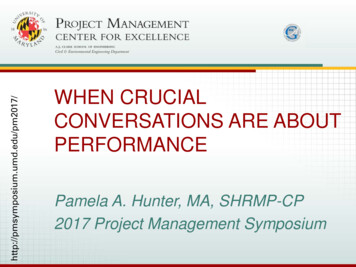
Transcription
um.umd.edu/pm2017/Pamela HunterUMD Project Management SymposiumMay 4-5, 2017Slide 1WHEN CRUCIALCONVERSATIONS ARE ABOUTPERFORMANCEPamela A. Hunter, MA, SHRMP-CP2017 Project Management Symposium
http://pmsymposium.umd.edu/pm2017/Pamela HunterUMD Project Management SymposiumMay 4-5, 2017Slide 2Performance ManagementAssumptions: True or False? Most employees want to do a good job. Employee’s performance can improveand their behavior can change, eventhough their basic personalities donot change. While some performance managementand appraisal forms and systems arebetter than others, managersdetermine the success or failure ofany program.
http://pmsymposium.umd.edu/pm2017/Pamela HunterUMD Project Management SymposiumMay 4-5, 2017Slide 3Performance ManagementAssumptions: True or False? People are our most important resource. Managing performance is a fundamentalpart of every supervisor’s job to ensure goalsare met. The most effective performancemanagement process is one that is ongoing a process that takes place day-in and dayout, not once a year.
http://pmsymposium.umd.edu/pm2017/Pamela HunterUMD Project Management SymposiumMay 4-5, 2017Slide 4Why then do we struggle somuch with managingperformance and having therequisite conversations withemployees?
Pamela HunterUMD Project Management SymposiumMay 4-5, 2017Slide 5http://pmsymposium.umd.edu/pm2017/When Conflict Controls What is conflict? What does conflict look likethrough the performancemanagement lens? Why should you care about thecost of conflict?
http://pmsymposium.umd.edu/pm2017/Pamela HunterUMD Project Management SymposiumMay 4-5, 2017Slide 6Conflict Defined "Conflict situations" are those inwhich the concerns of two peopleappear to be incompatible. –ThomasKilmann In performance management, conflictpresents in the differences (perceivedor real) between the supervisor andthe employee.
http://pmsymposium.umd.edu/pm2017/Pamela HunterUMD Project Management SymposiumMay 4-5, 2017Slide 7Conflict & etenceCommitment
Pamela HunterUMD Project Management SymposiumMay 4-5, 2017Slide 8http://pmsymposium.umd.edu/pm2017/Reality Check: The Cost of ConflictThe Dana Measure* is an online calculator that uses nine costfactors to estimate the cost of preventable, unbudgetedconflict. The conflict used below is based on an actual conflict.*Source: The Mediation Training Institute
Pamela HunterUMD Project Management SymposiumMay 4-5, 2017Slide 9http://pmsymposium.umd.edu/pm2017/“C” Through the Disconnect:What it takes to have crucial performance conversations toprevent differences from negatively impacting peformance Courage Coaching Commitment
http://pmsymposium.umd.edu/pm2017/Pamela HunterUMD Project Management SymposiumMay 4-5, 2017Slide 10“Success is never final, failure is never fatal.It’s courage that counts.” – John WoodenCOURAGE
Pamela HunterUMD Project Management SymposiumMay 4-5, 2017Slide 11http://pmsymposium.umd.edu/pm2017/The Courage to Overcome Conflict Recognize in order to repair. Keep the person and the problemseparate. Believe in the value of coaching. Commit to the coaching process. Trust the coaching process.“Unmanaged conflict is the largest reducible costin organizations today, and the least recognized.”- Dan Dana, Mediation Training Institute
http://pmsymposium.umd.edu/pm2017/Pamela HunterUMD Project Management SymposiumMay 4-5, 2017Slide 12“An ongoing process that tells youremployee what he or she does is significantto you and that it impacts the rest of thegroup.”– American Management AssociationCOACHING
Pamela HunterUMD Project Management SymposiumMay 4-5, 2017Slide 13http://pmsymposium.umd.edu/pm2017/Coach Your Way Out of the Conflict1. Build a working relationship basedon trust and respect.2. Communicate the gap betweenpresent performance and potentialperformance.3. Collaborate to set goals.4. Give specific feedback.
Pamela HunterUMD Project Management SymposiumMay 4-5, 2017Slide 14http://pmsymposium.umd.edu/pm2017/Steps of the Coaching Session Step 1: Set the tone. Step 2: Get agreement that a performanceissue exists (i.e., the gap between currentstate and desired state). Step 3: Discuss courses of action to closethe gap. Step 4: Mutually agree on appropriatecourse of action. Step 5: End the session on an encouragingnote with established follow-up sessions.
http://pmsymposium.umd.edu/pm2017/Pamela HunterUMD Project Management SymposiumMay 4-5, 2017Slide 15Practice Makes PermanentCOACHING IN ACTION:EXPERIENTIAL LEARNING
http://pmsymposium.umd.edu/pm2017/Pamela HunterUMD Project Management SymposiumMay 4-5, 2017Slide 16“Unless commitment is made, there are onlypromises and hopes but no plans.”– Peter DruckerCOMMITMENT
Pamela HunterUMD Project Management SymposiumMay 4-5, 2017Slide 17http://pmsymposium.umd.edu/pm2017/COMMIT TO PERFORMANCE IMPROVEMENT1.2.3.4.5.No surprises. The appraisal meetingshould not be the first time an employeeis hearing or learning about performanceissues.The lowest level of performance youaccept becomes the best performanceyou can require.The worst behavior you toleratebecomes the best behavior you canexpect.The more time you spend on the frontend of the process (i.e., planning, settingexpectations, developing standards,determining a coaching plan), the fewerissues you are likely to have at appraisaltime.It is the job of the manager to paint apicture of what a job looks like. If youcannot clearly describe a good job, canyou really expect the employee toproduce it?6.7.8.9.10.The cost of measuring should not exceedthe benefit you get from measuring.You get what you measure. “What youcount counts.” Measure the right thingsthe right way for the right reasons.Subjective does not mean arbitrary.Exercise your professional judgment andnot your personal opinion in assessingperformance. Focus on observablebehaviors that best reflect performancelevels. Remember, you can’t use it if youcan’t prove it.When establishing goals, you can onlyhold the employee responsible for thingsover which they have control.Trust the process. Comply with policy,stick to best practices, consult with HRfor sound advice on managingperformance and handling performanceissues.
Pamela HunterUMD Project Management SymposiumMay 4-5, 2017Slide 18http://pmsymposium.umd.edu/pm2017/Wrap-up & Review Make performance improvement apriority. Address problems immediately. Have the courage to deliver the toughmessage. Have the courage to take appropriateaction with the “un-coachable.” Let the employee or team member ownhis or her performance.
um.umd.edu/pm2017/Pamela HunterUMD Project Management SymposiumMay 4-5, 2017Slide 19QUESTIONS?THANK YOU!
requisite conversations with employees? Pamela Hunter UMD Project Management Symposium May 4-5, 2017 Slide 5. . What it takes to have crucial performance conversations to prevent differences from negatively impacting peformance. Pam
